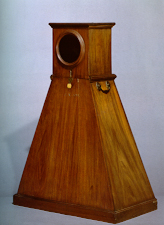
81.5 x 57.1 x 33.6
Wood, glass and brass
INDEX 1788 : ZI.II.IV.394
Capsa ex ligno Maognensi, quae in parte superiore capitulum sustinet cui interius infixum est speculum ad gradus 45 inclinatum, et exterius lens vitrea convexo concava. Huic pertinet Theca corio tecta in qua reperies immagines 84.
Mahogany box with upper part bearing a capital inside which is attached a mirror inclined at an angle of 45 degrees and outside which is a glass convex-concave lens. The set also comprises a leather covered case containing 84 images.
The optical chamber in the Gabinete de Física has the shape of a truncated pyramid, with a rectangular base and cut off at the top, where there is an extension in the form of a four-sided prismatic case. The sides of the pyramid have two brass handles for carrying purposes. A biconvex lens, 13 cm diameter, is mounted in the front of the prismatic case, through which one may look at the interior. A flat mirror is mounted inside the case, forming an angle of 45 º with the main axis of the lens. This optical system permits viewing of the magnificent images which are placed in the base of pyramid-body of the box. To ensure adequate illumination of the images, the back part of pyramid is open along almost all its length. The images are removed or introduced through this opening. The dimensions of the case and the positioning of the mirror, lens and engraving, as well as the focal distance of the lens, are such that the image given by the mirror is formed on the focal plane of the lens. Consequently, the final image produced by the lens and mirror, is formed in infinity, not requiring the effort to adjust the sight to view it.
The collection of images belonging to the apparatus used to number 84, but only 37 remain. Even in 1851, according to the inventory of the day, there were only 60.
These coloured images are stuck on to thin card and represent panoramic views and famous buildings in Paris, London, Rome, Venice, Florence, Amsterdam, Berlin, St. Petersburg and Malta. Many indicate the name of the artist and engraver. They were almost all printed by John Bowles & Son, in Black Horse, Cornhill.